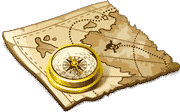THE TRASLATIO TOUR
JUBILEE TOUR ACROSS THE SEA
JUBILEE TOUR ACROSS THE SEA

For 1200 years, pilgrims have been walking across the spiritual and cultural path to Santiago de Compostela. The Pilgrim Way to Santiago de Compostela has been named First European Cultural Route by the Council of Europe and World Heritage Site by UNESCO.
The Traslatio Tour or Fluvial-maritime Jubilee Tour across the Mar de Arousa and the Ulla River honours the arrival of Saint James’ remains to Galicia, after his torture and death in Jerusalem.
Ancient Christian traditions state that St. James’ disciples, Theodore and Athanasios, accompanied the Apostle’s remains from Jaffa, a southern port city near Tel Aviv-Yafo, to Galicia. They sailed across the Mediterranean Sea and the Atlantic Coast of the Iberian Peninsula up to the Ría de Arousa and the O Grove peninsula.
They followed the course of the Ulla River and the Sar River to end at the Roman harbour of Iria Flavia, in the vicinity of Padrón. They moored the boat to a “Pedrón”, a Roman altar which is kept in Santiago de Padrón Parish Church. St. James was buried in Liberum Donum hill, in a place vaguely named as Arcis Marmoricis.
Both the municipal stamp of Padrón City Council and a coin found at the necropolis of Adro Vello recreate the iconography of the disciples on a boat lead by an angel.
The Traslatio Tour across the Mar de Arousa and the Ulla River was born in 1963. The initiative was driven by the Mar de Arousa and Ulla Jubilee Tour Foundation, an organization recognised for promoting the Way of St. James. Furthermore, the Traslatio tour was declared of Cultural and Galician interest by Xunta de Galicia in 1999.
On their behalf, the Nautical Club San Vicente do Mar issues nautical credentials to obtain the institutional document “Jubilee Traslatio”, issued by Padrón City Council and Mar de Arousa and Ulla Jubilee Tour Foundation.
The Mar de Arousa and Ulla Jubilee Tour Foundation promotes the yearly Traslatio celebration, which is carried out by the end of July and the beginning of August. A colourful maritime-fluvial procession that departs from different harbours in the Ría de Arousa and ends at Pontecesures and Padrón. This maritime procession is attended by a growing number of visitors every year who enjoy the route on the beautifully festooned boats.
The celebration is supported by the Jubilee, harbour authorities, the parish of Santiago de Padrón and, ship-owners and fishermen from the area.
Seventeen stone calvaries, which are located at the bottom of the estuary and at both shores of the Ulla River, mark the route of the only fluvial-maritime stations of the cross in the world. The first two calvaries marked at the Traslatio Tour are in Malveira Grande Island and in the north point of Cortegada Island. The traditional architecture of these calvaries shows, the crucifixion of Jesus Christ on one side of the stone cross and, Virgin Mary on the other side.